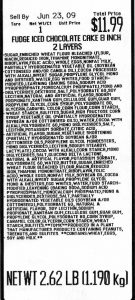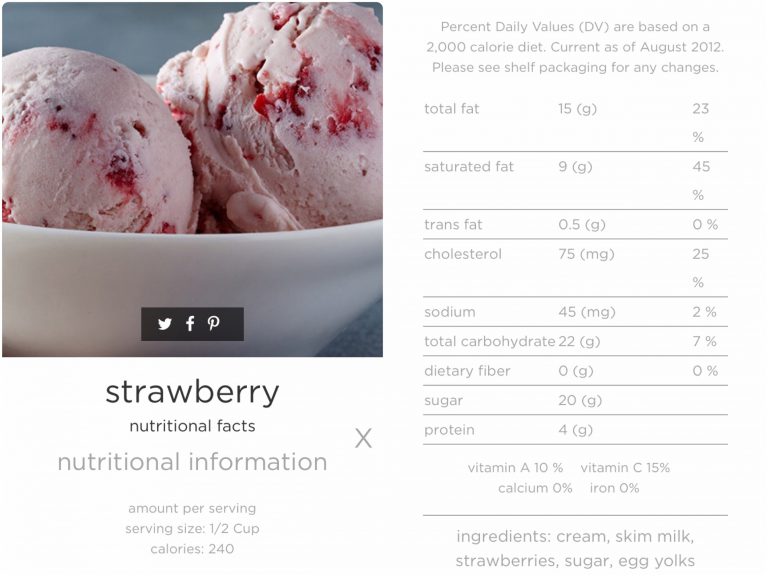A recent discussion with a colleague reminded me of a nutrition-related incident that happened while on vacation with my family last year, and it perfectly illustrates one of my nutrition philosophies: paying attention to food quality and the ingredients!
My Mom, brother, and I were in a large chain supermarket to pick up a few things to fulfill our grocery needs in the middle of our week-long home away from home. We got into a long check-out line, and my Mom said that she would be right back. A minute or so later, she returned to the line with a layer cake from the store’s bakery in hand. She declared, “I want us to have dessert!”
(Her “us” meant her and my brother. Not me, as she knows the cake is neither vegan nor gluten-free, so I can’t have any. We are used to this. It’s all good.)

It wasn’t even my initial intention to criticize the ingredients list, but this label caught my eye and I couldn’t stop staring. It was so long that it wrapped past the side of the clear plastic box and continued on underneath it. I wasn’t sure I have ever seen an ingredients list that long before! And it wasn’t just the length of the ingredients that bothered me … the number of horrifying synthetic chemicals that were on there made me cringe even more.
Propylene glycol monoesters, sodium stearoyl lactylate, glucono delta lactone, sodium proprionate ... where exactly in natures do you find these? Oh, you can’t. They come from chemical laboratories.
I don’t even know how many things are on that list, and I’m not about to count. Probably close to 100. Most of those ingredients came from a laboratory and were about as far from natural as you could get. Yes, some of them are vitamins and minerals, but they have to be added back because the extensive processing of the original foods stripped them of the inherent nutrients (i.e. whole wheat into white flour).
My Mom protested when I told her to put the cake back. She thought I was being unnecessarily strict, but she reluctantly went to return the cake to the bakery displays. She returned a couple minutes later with a pint of Haagen-Dazs ice cream. There were only five ingredients and each was an easily recognizable food: cream, skim milk, strawberries, sugar, and egg yolks.
I said, “Much better.”

“I don’t think I like going grocery shopping with a dietitian,” she grumbled.
No, I don’t imagine anyone likes being told they shouldn’t eat something that they had their heart set on eating – especially when you are looking forward to indulging in a dessert you either really enjoy or don’t have often.
When we got back to our accommodations for the week, she added that she was surprised I would rather her have the ice cream because the ice cream has more fat and calories than the cake. While that may be true, I actually care less about the amount of calories and fat you’re eating than the food quality you’re eating. Somewhere along the way, we as a society became too focused on the nutrients in food and we now tend to forget that minimally processed food is far better for our bodies than the highly/ultra-processed junk on grocery store shelves.
Going back to that example of the wheat flour, that is a great example of how excessive processing of foods cause them to lose the fiber, vitamins, minerals, and other beneficial nutrients that were originally in the grain of wheat when it came out of the ground. In an effort to make the end product (the white flour) a little bit more nutritionally like the whole wheat, the manufacturers add back some of the vitamins and minerals that science has identified as important micronutrients we would get if we ate the whole wheat.
There are several problems with this, though.
- Science has not identified ALL of the micronutrients found in food. Researchers are constantly finding new molecules in food and then maybe finding out what those molecules do in our bodies (the latter is not always an easy task – something I know all too well from having worked in a molecular biology lab). The vitamins and minerals we are aware of needing to maintain health are only a fraction of the molecules found in our food, and there is no way to be able to replace all of them when they are lost in processing.
- Synthetic vitamins and minerals are not nutritionally equivalent to the ones found naturally in food. One example is Vitamin E. There are multiple variations of the tocopherols in the Vitamin E family, and some studies have shown that no one form of tocopherol can perform the functions that Vitamin E is supposed to have in our bodies. While food manufacturers can attempt to replace the Vitamin E lost from processing by adding back multiple synthetic forms, there is no way this kind of fortification can exactly mimic all of the original micronutrient content.
- Some nutrients aren’t replaced after processing at all. Take fiber, for example. For white flour, fiber is extracted during processing. And because of the foods that are now staples in our Standard American Diet that require white flour and not wheat flour (since fiber from the hull of wheat interferes with texture and baking processes), we are eating foods where all the benefits of fiber are discarded away.
Then there are all those other unnatural chemicals that are needed in processed food as fillers, emulsifiers, stabilizers, preservatives, or to give texture to food. Yes, all of them have been deemed safe (or safe enough) to be added to food, but our bodies are not designed to digest or metabolize some of these chemicals. There is also the worry that there haven’t been enough long-term studies to determine whether or not frequent consumption of these chemicals is truly safe. Luckily none of the ingredients in that cake are red flag ingredients that are controversial, but there are ingredients in other foods where there is concern that they may be carcinogenic or otherwise potentially harmful.
In contrast, the ingredients in the ice cream are familiar and recognizable as food. You know where those ingredients came from – either directly from a plant or from an animal. (Yes, there is the question of the how the plants were grown or how the animals are treated or what they were fed, but that’s another discussion for another post.) While it is probably not known how well synthetic chemicals are digested or metabolized compared to whole foods, I don’t think it’s unreasonable to think that the whole foods we have been eating for hundreds or thousands of years are better digested than things that were developed in a laboratory in the last few decades.
So, read those ingredient labels before you look at the Nutrition Facts panels. Determine whether or not those ingredients are familiar and if they come from natural plants/animals. Think about what you are putting into your body.
The old adage “you are what you eat” applies every much today as it did decades ago. Feed your body high quality nutrients and give your body the best quality nutrients to work with to keep it function its best.
And yes, it’s totally fine to indulge in something richer in fat, sugar, or calories once in a while! As long as it is not a frequent habit. But when you do, make it count and choose something that is good food quality, made out of real food, minimally processed as possible, and not laden with artificial chemicals! Then savor it – take the time to really enjoy what you’re indulging in!